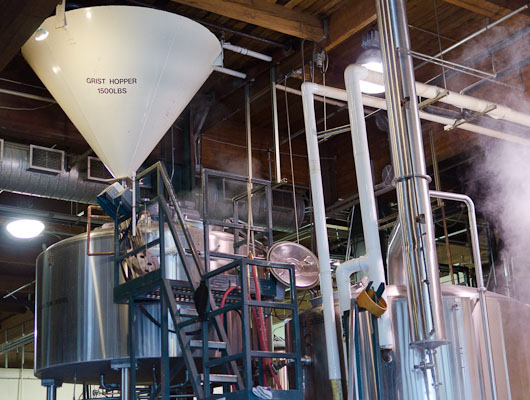Chamber Music I
Sunday, March 18, 2018 • 6:00 p.m.
Hale’s Brewery (4301 Leary Way NW, Seattle)
Program
Victor Ewald (1860–1935)
Brass Quintet No. 4 in A ♭ major, Op. 8
—intermission—
Johannes Brahms (1833–1897)
String Sextet No. 2 in G major, Op. 36
About the Concert
Members of Orchestra Seattle visit Ballard’s Hale’s Brewery to present the first of three chamber music concerts in unique venues. The Olympic Brass Ensemble rounds out their survey of the brass quintets of Victor Ewald with his A♭-major quintet, the earliest of the four (but the last to be published). Violinists Stephen Provine and June Spector, violists Sam Williams and Katherine McWilliams, and cellists Max Lieblich and Katie Sauter-Messick conclude the program with one of Brahms’s glorious string sextets.
The $25 ticket price includes one glass of wine or beer, with gratuity included on all drink redemptions and purchases. Just 60 seats available (purchase advance tickets); tickets will also be available at the door if any seats remain.

Program Notes
Victor Ewald
Brass Quintet No. 4 in A ♭ major, Op. 8
Victor Vladimirovich Ewald was born November 27, 1860, in St. Petersburg, where he died on April 16, 1935.
Between 1848 and 1850, Frenchman Jean-François-Victor Bellon (1795–1869) composed a dozen brass quintets, but these languished in obscurity for 150 years. Thus Victor Ewald, a Russian composer of German heritage, came to be acknowledged as the father of the brass quintet. Born in St. Petersburg, where he studied cello and composition at that city’s conservatory, Ewald maintained a “day job” as a successful professor of civil engineering while playing cello in an ensemble organized by Mitrofan Belyayev (a violist, timber merchant and music publisher) and widely recognized as the most influential string quartet in Russia.
Around 1888, Ewald — who also played cornet, horn and tuba — composed a quintet in A♭ major for five brass instruments. His B♭-minor quintet debuted a couple years later and became the first — and only — one of Ewald’s four quintets to be published (by Belyayev) during the composer’s lifetime. Ewald returned to the form some 15 years later, composing an E♭-major quintet, followed (around 1912) by a final quintet in D♭ major.
Ewald created these works for an ensemble consisting of two cornets, a rotary-valve alto horn, a rotary-valve tenor horn and tuba, but today they are generally performed by the standard brass quintet, substituting French horn and trombone for the alto and tenor horns. Because of their order of publication, the A ♭-major quintet is known as “No. 4,” although it was the first to be composed. Ewald also transcribed the work for string quartet, transposing it to E ♭.
Johannes Brahms
String Sextet No. 2 in G major, Op. 36
Brahms was born in Hamburg on May 7, 1833, and died in Vienna on April 3, 1897. He began composing this work in Baden-Baden during September 1864. The sextet had its premiere in Boston on October 11, 1866.
Luigi Boccherini and Ludwig Spohr were among the few composers to have written music for pairs of violins, violas and cellos before Brahms composed his first such work in 1859 and 1860 (Op. 18, in B ♭ major). Brahms returned to the form four years later during a period of nostalgia while on a summer holiday in Baden-Baden, creating what Sir Donald Tovey would call “the most ethereal of Brahms’s larger works.”
Encoded into a melody heard midway through the first movement’s exposition is the name “Agathe,” referring to Agathe von Siebold, a 23-year-old soprano to whom Brahms had briefly been engaged during 1859. “At the time I should have liked to marry, my music was either hissed in the concert hall, or at least received with icy coldness,” he later told a friend. “If, in such moments, I had had to meet the anxious, questioning eyes of a wife with the words ‘another failure’ — I could not have borne that!” After Brahms broke up with Agathe (he would never marry), she moved to Ireland to become a governess and later wrote a novel inspired by her romantic relationship with the composer.
The “Agathe” motive makes use of the notes A–G–A–B–E, omitting the “T” (in German, the note B♮ is known as H). It forms but one of several themes in the sonata-form opening movement. At the final appearance of the “Agathe” motive, Brahms underpins the last three notes with “A–D–E,” suggesting to some listeners that he is bidding her “adieu.”
The G-minor scherzo that follows opens in a 2/4 meter (typically scherzi were in triple meter) and with a theme drawn from a piano Gavotte Brahms had composed the previous decade; the central trio takes the form of a rustic L&aauml;ndler. The E-minor Adagio consists of a wide-ranging set of five variations on the movement’s opening theme (which dates from 1855, in a letter to Clara Schumann). The joyful finale, in 9/8 time, returns to G major.
